When does teething usually start. Baby Teething Timeline: When Do Teeth Emerge and How to Care for Them
When do babies typically start teething. How can parents recognize the signs of teething. What are effective ways to soothe a teething baby. How should parents care for their baby’s emerging teeth. When should a child have their first dental visit.
The Importance of Baby Teeth in Child Development
Baby teeth, also known as primary teeth, play a crucial role in a child’s development. These temporary teeth serve several important functions:
- Facilitating proper chewing and eating
- Supporting healthy jaw development
- Guiding adult teeth into their correct positions
- Aiding in clear speech development
Understanding the significance of these early teeth emphasizes the need for proper oral care from infancy.
Typical Teething Timeline: When Do Baby Teeth Appear?
While every child’s teething journey is unique, there is a general timeline for tooth emergence:
- 6-12 months: First 4 teeth (usually lower central incisors)
- 9-16 months: Next 4 teeth (typically upper central and lateral incisors)
- 13-19 months: First molars and possibly canines
- 17-23 months: Canines and second molars
- By 3 years: Full set of 20 primary teeth
It’s important to note that some babies may start teething earlier, showing signs before six months of age. Conversely, others might not get their first tooth until closer to their first birthday. This variation is normal and typically not a cause for concern.
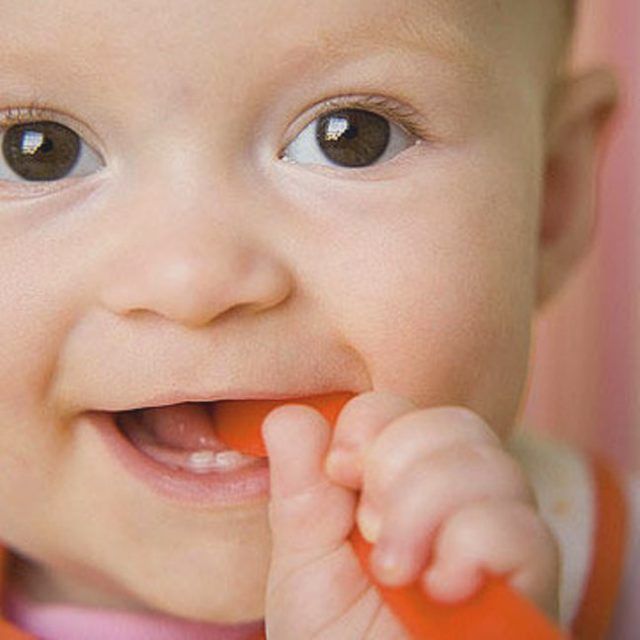
Early Signs of Teething
How can parents recognize when teething is beginning? Common signs include:
- Increased drooling
- Swollen or tender gums
- Increased fussiness or irritability
- Changes in eating habits
- Desire to chew on objects
It’s crucial to understand that teething does not cause fevers. If your baby develops a fever or shows signs of illness, it’s best to consult with a healthcare provider.
Effective Strategies for Soothing a Teething Baby
Teething can be uncomfortable for babies, but there are several safe and effective ways to provide relief:
- Offer a clean, chilled teething ring or toy
- Gently massage the baby’s gums with a clean finger
- Provide a clean, cool wet washcloth for chewing
- Give extra cuddles and patience during this time
It’s important to note that teething gels and ointments are not recommended due to potential side effects and limited effectiveness.
Establishing Good Oral Hygiene Habits from Birth
Proper oral care should begin even before the first tooth appears. Here’s a guideline for maintaining your baby’s oral health:

- From birth: Wipe gums daily with a clean, damp cloth
- When first tooth appears: Begin gentle brushing twice daily (morning and evening)
- Use a soft-bristled infant toothbrush
- Apply a rice grain-sized amount of fluoride toothpaste
- Gradually increase to a pea-sized amount of toothpaste by 36 months
Establishing these habits early helps set the foundation for lifelong oral health.
The Role of Fluoride in Protecting Baby Teeth
Fluoride plays a vital role in protecting baby teeth from decay. How does fluoride benefit developing teeth?
- Strengthens tooth enamel, making it more resistant to acid attacks
- Helps remineralize early stages of tooth decay
- Can be found in tap water in many areas (check with your local water authority)
- Applied professionally by pediatricians or dentists during check-ups
Parents should use fluoride toothpaste in appropriate amounts based on the child’s age, as recommended by dental professionals.
Proper Use of Pacifiers and Their Impact on Dental Health
Pacifiers, also known as soothers, can be a source of comfort for babies but require proper use to prevent dental issues:
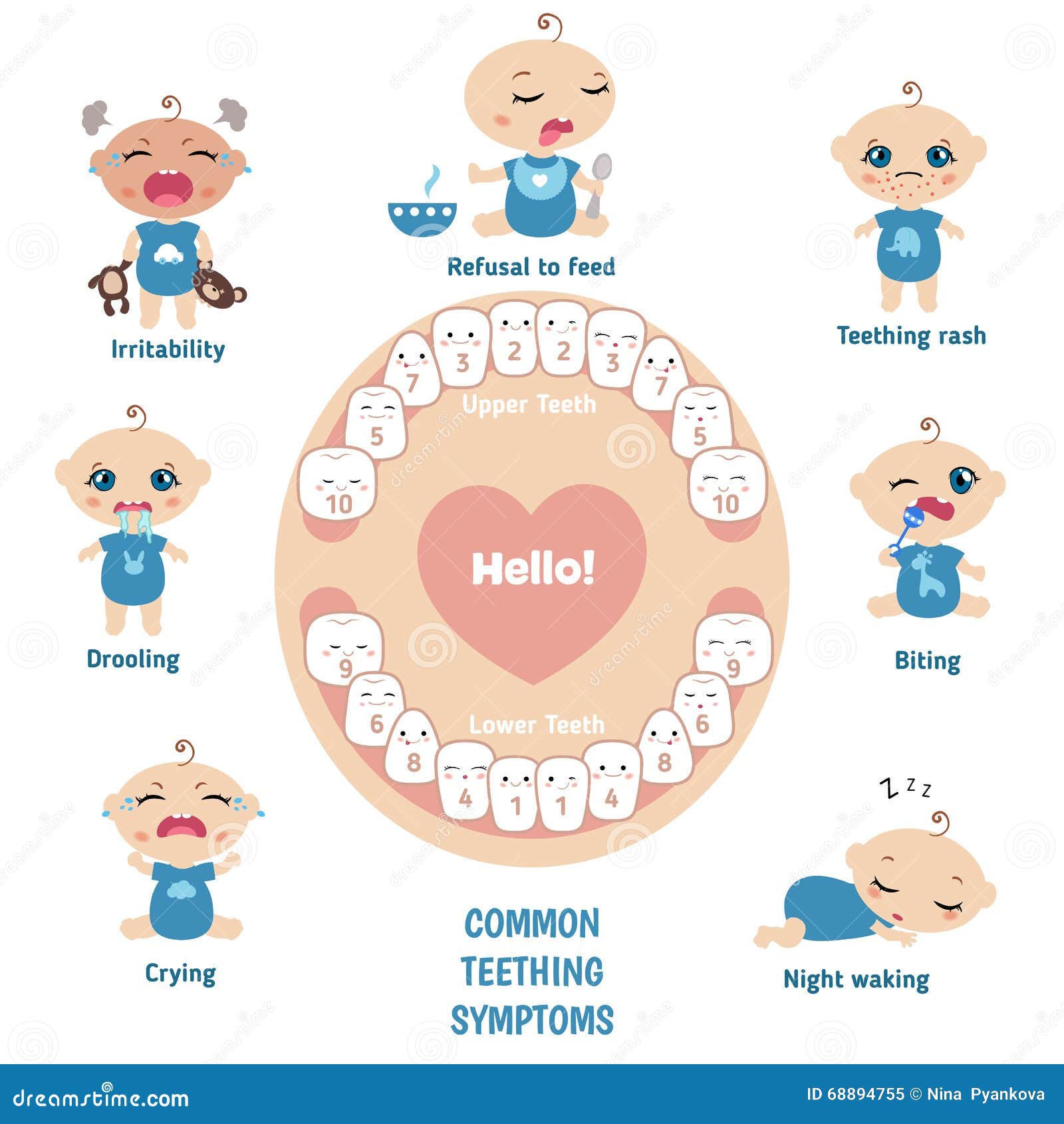
- Wait until breastfeeding is well-established (usually 4-6 weeks) before introducing a pacifier
- Choose an age-appropriate, one-piece design
- Regularly inspect for damage and replace as needed
- Keep pacifiers clean, but avoid “cleaning” them with your own mouth
- Never dip pacifiers in sweet substances
- Consider weaning from pacifier use around age 3 or when all baby teeth have emerged
While pacifiers can impact tooth development if overused, proper use and timely weaning can minimize potential dental issues.
When to Schedule Your Baby’s First Dental Visit
The American Academy of Pediatric Dentistry recommends scheduling a child’s first dental visit by their first birthday or within six months of the first tooth’s appearance. Why is early dental care important?
- Establishes a “dental home” for ongoing care
- Allows for early detection of potential issues
- Provides opportunity for parent education on proper oral care
- Helps the child become comfortable with dental visits
These early visits are typically short and focus on educating parents about proper oral hygiene practices.

What to Expect at the First Dental Visit
During your baby’s first dental appointment, the dentist will likely:
- Examine your child’s mouth, teeth, and gums
- Assess the risk of tooth decay
- Discuss proper cleaning techniques
- Address any questions or concerns you may have
- Potentially apply a fluoride varnish for added protection
This initial visit sets the stage for a lifetime of good oral health habits.
Common Myths and Misconceptions About Baby Teeth
There are several myths surrounding baby teeth that can lead to misconceptions about their care:
Myth: Baby teeth aren’t important because they fall out anyway
Reality: Baby teeth play crucial roles in eating, speaking, and guiding adult teeth into place. Neglecting them can lead to long-term dental issues.
Myth: Teething causes fevers
Reality: While teething can cause discomfort, it does not directly cause fevers. If your baby has a fever, it’s best to consult a healthcare provider.
Myth: It’s too early to start dental care before teeth appear
Reality: Oral care should begin at birth by gently cleaning the gums to remove bacteria.

Myth: Bottles at bedtime are harmless
Reality: Putting a baby to bed with a bottle can lead to tooth decay, often called “baby bottle tooth decay.”
Understanding these facts helps parents make informed decisions about their baby’s oral health.
Preventing Early Childhood Tooth Decay
Early childhood caries (ECC), also known as baby bottle tooth decay, is a serious but preventable condition. How can parents protect their child’s teeth from decay?
- Avoid putting baby to bed with a bottle
- Clean teeth and gums after each feeding
- Limit sugary foods and drinks
- Encourage drinking from a cup by the first birthday
- Use fluoride toothpaste in appropriate amounts
- Schedule regular dental check-ups
By implementing these practices, parents can significantly reduce the risk of early childhood tooth decay.
The Connection Between Diet and Dental Health in Infants
A baby’s diet plays a crucial role in their dental health. What dietary factors impact oral health in infants?
- Breastmilk and formula provide essential nutrients for developing teeth
- Introducing solid foods around 6 months helps jaw development
- Avoiding sugary foods and drinks prevents tooth decay
- Ensuring adequate calcium and vitamin D intake supports strong teeth and bones
Parents should consult with their pediatrician for guidance on appropriate nutrition for their baby’s age and stage of development.

Foods That Promote Healthy Teeth
As babies transition to solid foods, certain choices can support dental health:
- Cheese and yogurt (rich in calcium)
- Fruits and vegetables (provide vitamins and minerals)
- Whole grains (offer complex carbohydrates)
- Water (helps rinse away food particles)
Introducing a variety of healthy foods not only supports overall health but also contributes to strong teeth and gums.
Addressing Common Teething Complications
While teething is a natural process, it can sometimes lead to complications. What issues might arise during teething, and how can parents address them?
Excessive Drooling
Increased saliva production is common during teething. Parents can:
- Gently wipe the baby’s chin to prevent skin irritation
- Use a bib to keep clothing dry
- Apply a moisturizer if the skin becomes chapped
Disrupted Sleep Patterns
Teething discomfort may affect sleep. To help, parents can:
- Offer comfort and soothing before bedtime
- Maintain consistent bedtime routines
- Provide appropriate pain relief if recommended by a healthcare provider
Refusal to Eat
Some babies may be less interested in eating while teething. Parents can:
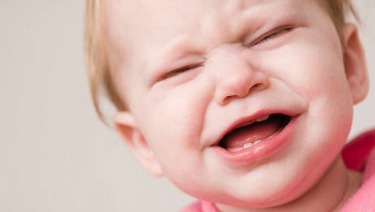
- Offer softer foods that are easier to chew
- Try cooler foods to soothe sore gums
- Be patient and continue offering regular meals and snacks
While these issues are typically temporary, persistent problems should be discussed with a healthcare provider.
The Role of Genetics in Teething and Dental Development
Genetics play a significant role in various aspects of dental development. How do genetics influence teething and oral health?
- Timing of tooth emergence can be influenced by genetic factors
- Tooth size, shape, and alignment may be hereditary
- Susceptibility to certain dental issues can have a genetic component
- Some rare genetic conditions can affect tooth development and oral health
Understanding the genetic factors at play can help parents and healthcare providers anticipate and address potential dental issues.
When to Seek Professional Advice
While variation in teething is normal, certain situations warrant professional attention:
- No teeth by 18 months of age
- Significant delays in tooth emergence compared to siblings or peers
- Abnormal tooth shape or color
- Signs of tooth decay or oral infections
In these cases, consulting with a pediatric dentist can help identify and address any underlying issues.

Preparing Siblings for a Teething Baby
When a new baby starts teething, it can affect the entire family. How can parents help older siblings understand and cope with a teething baby?
- Explain the teething process in age-appropriate terms
- Involve siblings in soothing activities, like singing or gentle play
- Acknowledge their feelings and provide extra attention when possible
- Create a quiet space for siblings if the baby’s fussiness becomes overwhelming
By involving siblings in the process, parents can foster empathy and strengthen family bonds during this challenging time.
Long-term Dental Health: From Baby Teeth to Adult Smile
The care given to baby teeth sets the stage for lifelong oral health. How do early dental habits impact long-term oral health?
- Proper care of baby teeth helps ensure correct spacing for adult teeth
- Early positive dental experiences promote ongoing comfort with dental care
- Good oral hygiene habits established in childhood often carry into adulthood
- Addressing dental issues early can prevent more serious problems later in life
By prioritizing dental care from infancy, parents lay the foundation for their child’s healthy adult smile.
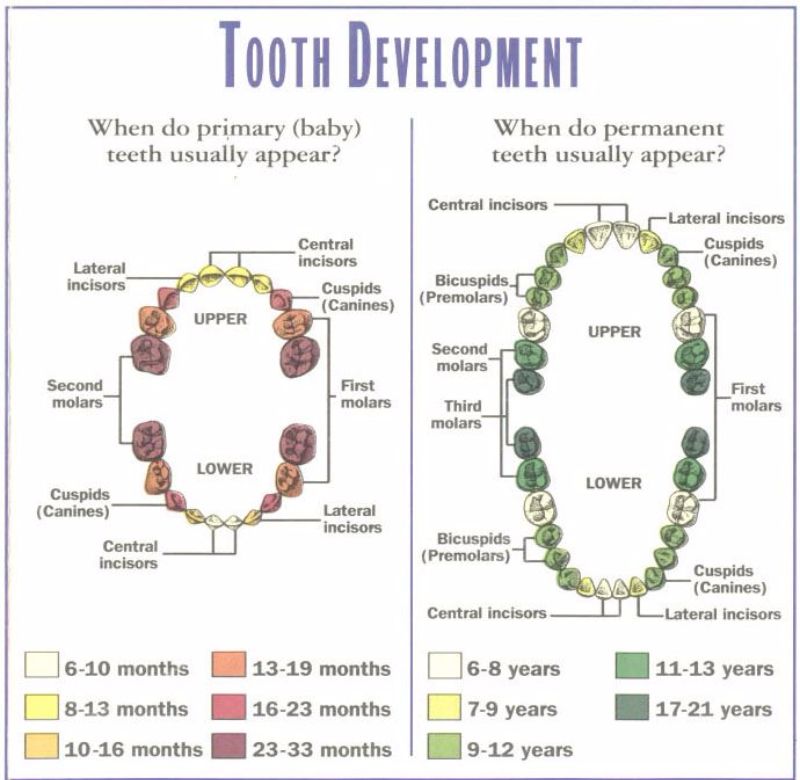
Transitioning from Baby Teeth to Adult Teeth
As children grow, they’ll experience the exciting process of losing baby teeth and gaining adult teeth. What should parents know about this transition?
- Baby teeth typically start falling out around age 6
- The process of losing all baby teeth can take several years
- Adult teeth may come in before baby teeth fall out, creating temporary “shark teeth”
- Regular dental check-ups are crucial during this transition period
Understanding this process helps parents support their child through the changes and ensure proper care of emerging adult teeth.
By following these guidelines and maintaining regular dental check-ups, parents can help ensure their child develops a healthy, beautiful smile that lasts a lifetime. Remember, every child’s dental journey is unique, so don’t hesitate to consult with dental professionals for personalized advice and care.
Early teething and tooth care
How to establish good oral habits early.
Baby teeth are important for:
- Eating
- Proper jaw development
- Guiding adult teeth in place
- Speaking clearly
Most baby teeth come around six months, but sometimes earlier and babies can show signs of teething before six months of age. See the chart below for average ages of tooth development.
Coping with teething
A common sign that a new tooth is coming is increased drooling. Teething may cause discomfort, making your baby fussy. Your baby may not want to eat.
- Give your baby extra love and patience.
- Allow your baby to chew on a clean, chilled teething ring, teething toy, or clean wet face cloth.
- Teething gels and ointment are not recommended.
Teething does not cause fevers. If you have any concerns, call 8-1-1 to speak with a nurse or contact your health care provider.
Good dental health starts at birth
- From birth, even before teeth appear, wipe your baby’s gums daily with a clean, wet cloth.
- Once baby teeth appear, gently brush your baby’s teeth (once in the morning and after the last evening feeding) with a child’s toothbrush
- Use a rice grain-sized of fluoride toothpaste. As more teeth appear, gradually increase the amount of toothpaste up to a pea sized amount by the age of 36 months.
Use soothers properly
Some worry soothers can impact tooth development and growth. Here are some soother tips to start healthy dental habits early and prevent tooth decay.
- Ensure that breastfeeding is well established (no problems breastfeeding and enough milk production, usually around four to six weeks) before introducing a soother.
- Choose the right size soother for your baby’s mouth and make sure it is a one piece design.
- Check the soother nipple often – throw it away if it is sticky, cracked or torn, or if the nipple is not firmly attached.

- Sterilize the soother before first use, by boiling it in water for five minutes and let it cool completely.
- Keep the soother clean.
- Avoid licking your baby’s soother to clean it, adult mouths can transfer tooth decaying bacteria.
- Avoid dipping the soother in honey or other sweet substances that can cause tooth decay and are unsafe for young children.
- Soothers or pacifiers are not recommended once all baby teeth have grown in, usually when your child is about three years of age.
- Never tie anything to the soother to attach it or hang it from your toddler. It can be a choking hazard. Use a clip with a short ribbon attached instead.
- Parents can start to wean children off the soother as soon as possible.
Learn more about soothers and tips to wean your child from one.
Baby Teeth 101: When Do Your Baby’s Teeth Come In?
This post is also available in:
Español (Spanish)
We’re often asked by our families when their baby’s teeth come in and how early we see babies for dental care.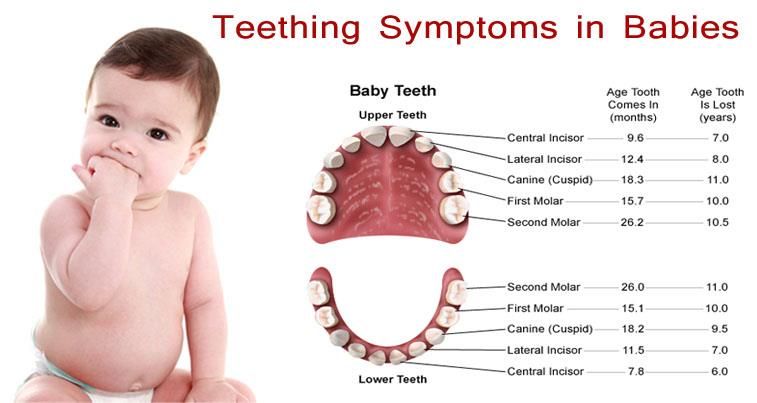 We put together this helpful infographic for you.
We put together this helpful infographic for you.
When babies reach 3 months of age, they’ll start producing more saliva and exploring the world with their mouth… but that doesn’t mean that they’re teething. A baby’s first tooth usually appears around 6 months of age but may even take a year. Most children have all their baby teeth by age 3.
Here’s the breakdown – take a look at the graphic below for the order each tooth will come in at:
- Ages 6 to 12 months – your baby will start to get their first 4 teeth. At 6 months of age, you can begin using tap water in their bottle – which helps prevent tooth decay.
- Ages 9 to 16 months – your baby may have its first 8 teeth. We accept appointments to see your baby when they turn one year old.
- Ages 13 to 19 months – your baby may have its first 12 teeth.
- Ages 17 to 23 months – your baby may have its first 16 teeth.
- Ages 12 – 33 months – your baby may have its first 20 teeth.

Care for Teething Pain
Parents often notice discomfort and additional saliva as babies get their first tech. You can help ease teething pain by massaging your baby’s gums with clean fingers. You can also provide solid, teething rings or a clean frozen or wet washcloth.
Care For Your Baby’s Teeth
During your well-baby visits, your pediatrician will check your baby’s teeth and gums. They’ll make sure they’re healthy and talk to you about how to keep them that way. They’ll also typically apply fluoride varnish to help protect them.
When your baby gets its first tooth, you can begin brushing them twice a day. We recommend buying a soft-bristle baby toothbrush with a smear of toothpaste about the size of a grain of rice. You also won’t want to put your baby to bed with a bottle as it can lead to tooth decay.
Your Baby’s First Dental Visit
At PrimeSmile, we want your child’s first dental visit to be a great experience. The first visit is recommended at your baby’s first birthday – within 6 months of the first teeth coming in. To make things comfortable, we can use a private room.
To make things comfortable, we can use a private room.
The first visit will include a full exam of your child’s mouth – including teeth, jaws, bite, and gums. We’ll also provide a gentle cleaning and show you how to properly care for their teeth, including brushing and flossing.
This post is also available in:
Español (Spanish)
Teething – Everyday.Clinic
Some babies are born with their first teeth. For others, teeth begin to erupt before 4 months, and for some after 12 months. But most babies start teething around 6 months.
⠀
Teething symptoms:
⠀
Sometimes baby teeth erupt without pain or discomfort.
⠀
In other cases, you may notice the following symptoms:
⠀
– pain, swelling, redness of the gums
– moderate increase in body temperature (up to 38 degrees)
– redness of the cheeks, sometimes on one side
– child rubs ears
– child is more restless than usual
– child chews on things and hands
– child is irritable and does not sleep well
– irritation, rash on cheeks
Many parents think that teething causes fever and diarrhea, but researchers say that these symptoms are not signs of teething. If your child has a temperature above 38 C or diarrhea, see a doctor.
If your child has a temperature above 38 C or diarrhea, see a doctor.
⠀
In what order do teeth erupt?
● Lower incisors (lower front teeth) – These usually appear first, usually between 5 and 7 months of age.
● Upper incisors (upper front teeth) – these usually erupt between 6 and 8 months of age.
● Upper lateral incisors (on either side of the upper front teeth) – these erupt between 9 and 11 months of age.
● Lower lateral incisors (on both sides of the lower front teeth) – these erupt between 10 and 12 months of age.
● First molars (back teeth) – they erupt between 12 and 16 months of age.
● canines (between lateral incisors and first molars) – they appear between 16 and 20 months of age.
● Second molars – erupt between 20 and 30 months of age.
In most children, all milk teeth erupt by the age of 2-3 years. However, it is worth remembering that all children are different and the timing may be different.
⠀
How to relieve teething symptoms?
● To relieve the pain of teething, one of the best remedies is a gentle massage of the gums.
● special teethers can also be used for massage, they can be cooled (do not freeze)
● offer cool food and drink to the child
● if teething symptoms make the child feel much worse, antipyretic drugs such as paracetamol or ibuprofen can be used
Do not use:
– gels with local anesthetics: the effectiveness of these drugs has not been proven, but there is a risk of side effects
– homeopathic remedies are also not have proven effectiveness
– beads: may cause suffocation
⠀
Prevention of teething rash:
⠀
One of the main signs of teething is salivation, which can lead to rashes on the skin (cheeks, neck). In order to prevent the appearance of a rash – wash the child after contact with saliva and food, pat the skin dry after washing, do not rub, use barrier creams with zinc.
Author: pediatrician and allergist Maria Makhova.
Personal Doctor – News
A child’s teething period is quite long: teething usually starts at 5-6 months. Very rarely, teeth can begin to erupt when the child is only a month old, and for someone, on the contrary, late at 1 year old – this is an individual feature.
Very rarely, teeth can begin to erupt when the child is only a month old, and for someone, on the contrary, late at 1 year old – this is an individual feature.
However, it happens that late teething is associated with the development of rickets or nutritional errors. If the teeth have not started cutting by 9 months, you should see a doctor.
The period of teething ends at about 2-2.5 years.
During teething, the child may be anxious, but this anxiety should not last more than a few days and drastically change the life of the family.
MYTH 1 – The child does not sleep well – it’s true!
If he sleeps badly, often wakes up, this may be, but if he roared so that he cannot be calmed down for an hour, then this is not connected with the teeth, you need to look for the cause.
MYTH 2 – Teething can cause a high temperature – not true!
If the child has a temperature increase for teething, which often happens, then it should not be 38-39 degrees. In this case, most likely, some kind of viral infection has joined in parallel.
MYTH3 – A child can refuse food – not true!
A child can really eat badly during teething, but in no case completely refuse food – this is not the norm.
MYTH 4 – teething is often accompanied by a runny nose and cough
Often, mothers associate a runny nose in a child with teething, we’ll say right away that there can be no runny nose and cough due to teething. Rather, we are talking about the layering of a viral infection.
MYTH 5 – loose stools in a child due to teething –
When teething, a child produces a large amount of saliva, so the stool may be slightly thinner than usual, but in no case should this be profuse diarrhea. We must not forget that children of this age often put everything in their mouths, so the chances of catching an intestinal infection are high. If the child’s stool has changed dramatically, this is also a reason to consult a doctor.
How can you alleviate the condition of the child?
More recently, a fairly large number of gels have been used to facilitate teething and calm the mother.:max_bytes(150000):strip_icc()/teething_start_and_end_0-ae9d717c51e547f5b090715487cc56e2.jpg)


